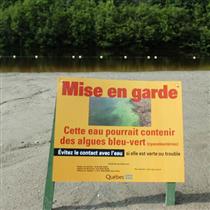"The truth is incontrovertible, malice may attack it, ignorance may deride it, but in the end; there it is."
~ Winston Churchill
~ Winston Churchill
 Algues rouge dans Baie Groulx August 2008
Algues rouge dans Baie Groulx August 2008 Algues rouge dans Baie Groulx August 2008
Algues rouge dans Baie Groulx August 2008Algues dans Baie Groulx et Baie Yelle en 2008!
(et Algues Bleu dans Baie Ours en 2005)
************************
Video: Study raises worries over toxin in Canadian lakes
CTV Winnipeg
Liver toxins prevalent in western cottage country’s lakes, cross-Canada study finds
Globe & Mail
Manitoba, Alberta lakes surveyed have high levels of toxin
CBC
A survey of more than 250 lakes across Canada has found a potent liver toxin in every province, with the highest concentrations in central Alberta and southern Manitoba.
The survey published in a scientific journal has found the toxin in certain types of blue-green algae.
The toxin, called microcystin, is found in lakes heavily loaded with nutrients from agricultural runoff and development.
The survey found nearly 10 per cent of the 256 lakes surveyed had microcystin levels that exceeded Canadian guidelines even for recreational use. MORE >>>
 Potent human toxins prevalent in Canada's freshwaters Canadian Journal of Fisheries and Aquatic Sciences
Potent human toxins prevalent in Canada's freshwaters Canadian Journal of Fisheries and Aquatic Sciences Ottawa, Ontario (August 14, 2012) – Nutrient pollution, one of the greatest threats to our freshwater resources, is responsible for the algal blooms that blanket our lakes and waterways in summer months. Large blooms of cyanobacteria (‘blue green algae’) can cause fish kills, increase the cost of drinking water treatment, devalue shoreline properties, and pose health risks to people, pets, and wildlife. A new paper just published in the Canadian Journal of Fisheries and Aquatic Sciences shows that microcystin, a toxin produced by cyanobacteria, is present in Canadian lakes in every province.
“Canadians enjoying their summer at the cottage need to know that those green scums of algae washing up on their beach are not only unsightly, but can also be a threat to their health and their children’s health,” says lead author, Diane Orihel, a researcher with the Department of Biological Sciences at the University of Alberta. “It’s time to get serious about cleaning up the nutrients polluting our lakes.”
Microcystins are well-established as potent liver toxins to humans and other mammals, and are classified as possible human carcinogens. "Blue-green algae present a growing health concern for domestic, agricultural and recreational water use in Canada and world-wide”, warns Dr. David Kinniburgh, the Director of the Alberta Centre for Toxicology at the University of Calgary. “The microcystin toxins they produce can cause acute liver failure in humans and may even cause cancer with long-term exposure."
This study is the first to report on microcystin prevalence at a national scale–data from 246 bodies of water across Canada were collected. The authors determined that water quality was most at risk in lakes with the highest concentrations of nutrients. Nutrient-rich lakes and reservoirs, particularly in central Alberta and southwestern Manitoba, proved to have highest toxin concentrations, though all regions in Canada contained lakes that reached microcystin levels of concern.
A very important finding–that calls for further research–was the strong association between low nitrogen-to-phosphorus ratios and high microcystin concentrations. The authors recommend whole-ecosystem experiments be performed to understand how changing nutrient inputs to lakes affects microcystins and other cyanobacterial toxins. This information is essential for governments to develop effective management strategies for improving water quality in nutrient-polluted lakes.
"Harmful algae blooms are a growing problem worldwide. The more we look, the more we find,” remarked international water expert Dr. Stephen Carpenter, Director of the Center for Limnology at the University of Wisconsin-Madison, “Orihel and colleagues help define the conditions when we would expect highly toxic freshwater. These insights make it possible to focus management and research on the highest-risk situations."
“This study addresses an issue that has important health consequences, but also highlights the importance of both the underlying basic science and monitoring programs essential to determine environmental changes,” says Don Jackson, Co-Editor of the Canadian Journal of Fisheries and Aquatic Sciences.
The paper “High microcystin concentrations occur only at low nitrogen-to-phosphorus ratios in nutrient-rich Canadian lakes”, published in the Canadian Journal of Fisheries and Aquatic Sciences, is available Open Access at http://www.nrcresearchpress.com/doi/full/10.1139/f2012-088












